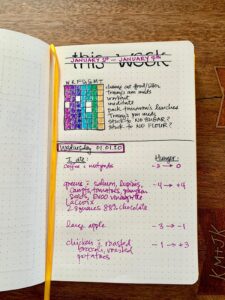January 1 often brings a mix of feelings, including a sense of renewal and motivation to make positive changes in our lives. For those of us who struggle with weight (and who might have overindulged during the holiday season, maybe even starting as early as Halloween), making a New Year’s resolution with the meta goal of creating a healthier body (often via weight loss) in the new year is familiar. Yet, how often have you attacked that goal with fervor for a few days or weeks, only to veer off the path toward a “healthier you” within the first few weeks or months… and then just give up entirely? You’re not alone: in a survey of over 12,000 women, about 50% of women in all weight classes reported having weight loss as a New Year’s resolution over the prior 2 years, and the majority of such women reported having made 2-5 annual attempts to lose weight.
Hundreds of studies have looked at goal setting and achievement, and found that specific and concrete goals are more motivating (and lead to more effort and goal pursuit, and thereby more success) than more vague goals.
For example, a goal to “lose weight” is quite abstract, and is really more of a dream than a goal. The goal to “lose 100 pounds” is more specific, but still somewhat vague in that there is no clear plan or end point specified. The goal to “lose 5 pounds by February 1” is much more specific, and can be broken up into even more concrete “subordinate” goals which essentially serve as the plan for exactly what to do and how to do it. For example, specific subordinate goals intended to get you to that 5 pounds weight loss might be to “eat a serving of vegetables or fresh fruit before each meal,” “stop drinking sugar-sweetened beverages,” or “walk to and from work every day for the next 4 weeks.” These types of goals are the key to success, and are often referred to as SMART goals: Specific, Measurable, Achievable, Relevant, and Time-bound. Research has shown that having a clear attainable end point in relatively close proximity significantly increases motivation and goal pursuit. But focusing entirely on the smaller more concrete goals can be demotivating over time – after all, the vision that you have of yourself and your life after you achieve the big-picture goal that is driving you to make these smaller changes, right? Without that meaningful meta goal, or “superordinate” goal, you are much less likely to actually stick to the smaller subordinate goals. The big picture superordinate goal represents your ultimate achievement — what you really value and aspire to. It provides context for those smaller, achievable goals. If each small subordinate goal is a stepping stone in a dark tunnel of effort, you want to be able to see the light — the ultimate superordinate goal — at the end of that tunnel to keep you motivated to keep trudging through.
So here is my advice for how to best lay out your New Year’s resolution for 2020 if your goal is one that you’d like to stick with long-term and actually achieve. (If you’d like to see an example of my own, I’ll include it at the very bottom.)
Sit down with a pen and paper and give yourself 15-30 minutes to hand-write your responses to each of the following questions:
- Think about your vision for your life — the superordinate big picture goal. (E.g., “I want to be a normal weight.”) Write it down.
- Describe what that achievement looks like in concrete terms. (“I want to lose 102 pounds to achieve a BMI of 24.9.”)
- Dig deeper into WHY this goal has meaning for you. (“My weight is creating health problems for me, including diabetes and high blood pressure, and I want to improve my health.”)
- Now dig deeper still to think about why THAT is important to you. (“I want to live another 40 years to see my children have children of their own and experience the joy of grandparenthood.”
Repeat step 4 until your original goal is connected with who you want to be, with something that will make your life truly meaningful — something that feels immensely powerful to you. Try to make it a positive, motivating statement (“I want to live to see my beautiful grandchildren grow up”) rather than a negative or self-deprecating one (“I want to stop feeling so tired and unhappy with my appearance”). Positive visions are more likely to drive identity-congruent positive actions.
- Next, think about the concrete intermediate steps that you will need to take in order to be able to achieve your big picture goal, and write them down. (“I will lose at least 5 pounds per month every month, consistently, until I lose all 102 pounds.”) Breaking up the big — often overwhelming — goal into smaller intermediate goals makes them actually achievable. After all, you don’t have to lose 102 pounds. You just have to lose 5 pounds. And then do it again… 19 more times.
- Now brainstorm all of the different subordinate SMART goals that you can think of that will help you achieve that smaller intermediate goal. Do a brain dump and write down everything you can think of. You do not have to do all of them, but you want to have as many options to choose from as possible. Make sure each one is specific, measurable (it must be clear whether you achieved it or not), achievable (realistic is key – walking to and from work is likely more achievable than running a marathon if you are currently sedentary), relevant (the goal should be something that is expected to help you toward your main goal, obviously), and time-bound (short-term deadlines like “go to the gym at least 3 times each week for the month of January” are important to get your butt in gear; without a time-bound plan, it’s easy to procrastinate).
- Choose at least 3 of these subordinate SMART goals that you are committed to achieving, and then brainstorm every possible obstacle you can foresee getting in your way. Come up with if/when contingency plans for how you will deal with each of those obstacles. For example, if one of your chosen SMART goals is to stop drinking sugar-sweetened beverages because you’re a caramel macchiato addict, and you know that your best friend at work also loves to hit the Starbucks in your office building with you and will ask you to join them for a coffee break, think about various strategies in advance for how you can stick with your plan (e.g., decide in advance that you will go, but that you will only order a café Americano with heavy cream). Advance contingency planning can make a huge difference.
- Choose a start date (presumably January 1 in the context of setting a New Year’s resolution), and enter the specifics for each of your SMART goals into your calendar whenever possible. So, if one of your goals is to go to the gym at least 3 days per week for the month of January, look at your calendar and enter the commute and gym time into actual date/time slots in your calendar that you know you can honor. And then stick with that plan. Checking off boxes can actually be rewarding to our brains, so posting a calendar on your fridge or other easily-accessible spot and actually putting in boxes for each occasion and physically checking them off (and seeing that visual reward of the checked-off boxes) can help with motivation. (Even for things that are not scheduled at a specific time, like avoiding those caramel macchiatos, creating a check box in your calendar that says “no sugar-sweetened beverages” for you to check off at the end of each successful day can provide a reward for your brain, especially as you see those checked boxes accumulate over days and weeks.)

- Each month, set aside time (enter it into your calendar!) to re-brainstorm your big goal and the smaller SMART goal steps you could take to achieve it, and while continuing to stick with the changes you’ve already made, add in one or two more SMART goals that you can realistically add. Small successes build momentum and it becomes easier to add in more and more small changes once you’ve mastered the first few.
- Engage in thinking about the big picture/superordinate goal whenever you fail at achieving one or more of your SMART goals, as is likely to happen. Resilience in the face of setbacks and learning from failures are the key to long-term goal achievement, and being flexible about setting new, different SMART goals that can help you achieve your meta goal will make the difference between ultimate success and giving up on the big goal entirely. EXPECT that you will falter. Seeing more boxes checked than unchecked is a worthy achievement, so don’t give up just because you didn’t follow your plan 100%. Perfect is the enemy of the good when it comes to weight loss.
There are a few days left before we enter a new decade, and I, for one, will be one of those people with the New Year’s resolution to lose weight. My goal is to reach 135 pounds by April 1, which will put me right in the middle of the normal BMI range for my height. I’m committed to this resolution this year.
Who’s with me?
See you in 2020!
Love, Jen
MY OWN GOAL-SETTING EXERCISE:
- My superordinate big picture goal:
I want to achieve my dream weight. - What that achievement looks like in concrete terms:
I want to lose 12 pounds (and reach 135 pounds) by April 1, 2020. - WHY this goal has meaning for me:
I feel really great both physically and emotionally when I am lighter. My health is better when I am lighter. My bad back will worsen with extra weight, and I am at high risk of developing Alzheimer’s Disease based on my family history. - Why THAT is important to me:
I had Graham at an older age, and am almost 46 years old as he just turned 3. He is an only child and I want to preserve my own health as long and best as possible to enjoy watching him grow up and to spare him (for as long as possible) the responsibility of helping care for me in my old age. I hope to see him partner up and experience the joy of having children of his own one day, so that I can experience the joy of watching him parent and the joy of being a grandparent. - Concrete intermediate steps toward my superordinate goal:
I will lose 6 pounds by February 1 (goal weight 141), then another 4 pounds by March 1 (goal weight 137), then the final 2 pounds by April 1 (dream weight: 135). - Brainstorm all of the potential subordinate SMART goals that could help me achieve my goal of 6 pounds lost by February 1:
Keep a basic food journal and note how physically hungry I am on the hunger scale from -10 to +10 before and after every eating occasion; only eat when physically hungry (a -2 or hungrier) and stop eating by a +4; fast each morning until lunch and stop eating by 7pm; all eating occasions sitting down and without distractions so as to eat mindfully (no eating while surfing the ‘net, working at my desk, standing in the kitchen, etc.); eat no added sugar until I reach my goal weight; eat no flour-based foods such as bread or pasta until I reach my goal weight; continue working out on the elliptical for at least 30 minutes each morning at least 6 days per week; guided meditation at least 10 minutes on at least 5 days each week to train myself in mindfulness; get to bed by 9pm each night and prioritize > 7 hours of sleep; stop drinking alcohol entirely until I reach my goal weight; eat no nut butter (my go-to treat that I tend to overeat when I am off sugar!); intentionally leave food uneaten on my plate at least one meal per day to practice stopping when I am satisfied rather than automatically finishing my plate; meal plan/prep each weekend for the coming week to make food decisions ahead of time with my prefrontal cortex and avoid allowing my primitive brain to dictate food on the fly - My 3 chosen SMART goals and their potential obstacles and solutions:
- Eat no added sugar.
Obstacles and solutions:- Tempting sugar/sweets in my immediate vicinity: move sugar canister, honey, and other sweets from pantry into garage; have healthy alternatives (eg my roasted wasabi edamame packs, fresh fruit) on hand for immediate eating if hungry
- Someone offers me a sweet as a gift: thankthem profusely and say honestly that sugar makes me feel sick (or that I have a sugar addiction I am trying hard to overcome) so I can’t eat it (or if I don’t want to get into my personal weeds, accept the sweet and say I’m saving it for later and then give it or throw it away)
- Hunger leaves me vulnerable to grabbing a sweet treat: plan and prep meals for the day in advance so that I know what I will be eating and don’t leave any decisions to my primitive brain; always have pre-chosen foods on hand (eg edamame packets in my purse)
- Eat no flour-based foods.
Obstacles and solutions:- The same as above for sugar;
- Kevin forgets I am avoiding flour and prepares a dinner with pasta or other flour-based foods: have prepped meal options on hand at home in the freezer that I can eat in a pinch
- Eating in a restaurant: look at their menu online before arriving and choose what I will eat in advance, remove bread basket, tortilla chips, or other restaurant flour-based freebies from the table (or from my immediate vicinity if with a group of friends who want them)
- Keep a food journal with hunger scale (with intention to eat only when physically hungry).
Obstacles and solutions:- Eating on the fly or don’t have my journal with me: jot it down in the notes app on my phone or email it to myself to record later
- Not hungry by dinner time and afraid I’ll get hungry before bed: plan a hearty lunch with plenty of fiber and protein to keep my hunger at bay and avoid snacking before dinner, eat 1/3 of the dinner even if not hungry and take note of what I ate earlier that kept me from being hungry so I can tweak my plan for future days, just don’t eat unless I’m hungry and if I’m hungry right at bedtime I can eat a handful of nuts or other snack
- Eat no added sugar.

